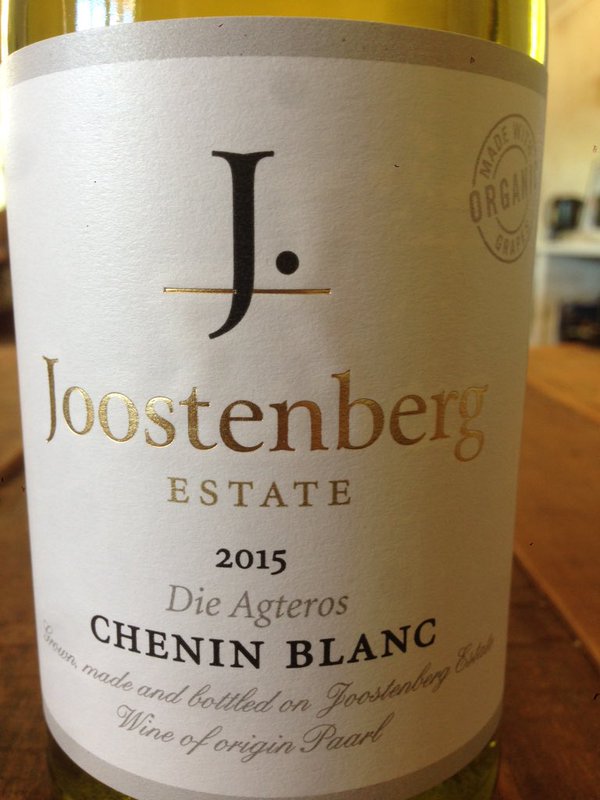News
Yesterday, David Clarke tweeted the photo below with the announcement: An important word appearing on @JoostenbergWine labels from the 2015 vintage onwards…
It didn’t take much brain power to work out that ‘Estate’ is the important word in question. But why is it important, in fact is it important?
Clarke explained to me that the Myburgh family had decided ‘to apply for the registration as a unit for the production of estate wine’ (until 2003, estates were the smallest wine of origin, so a place rather than just a wine) because they want to focus on Joostenberg the place and the grapes grown on it with the current focus on vinifying small batches of the different varieties on the farm. In his own words, cellarmaster, Tyrrel Myburgh explains it thus: ‘We believe in the fundamental importance of origin (terroir if you like) and organics, estate vineyards, dry-farming are all part of unlocking this.’ The organic certification, done according to both EU and US standards, is done by Control Union, a European company.
What the Myburghs are not claiming is that the wines are better because ‘Estate’ is now on the label. It won’t be on every label at present, as Joostenberg wines were accorded ‘Estate’ status only from 2015. What it does signify is that the growing, winemaking and bottling processes all take place on their farm. A move they feel more beneficial, as it allows them to concentrate solely on their vines. Something they are doing in as honest and unmanipulative manner possible.
Now, I have huge respect for the Myburghs and their wines; Tyrrel has always shown a sensitive, deft hand and I know when I open a bottle of Joostenberg that it’ll be something to sip and enjoy. Even more so now that Tyrrel has taken his wines a further step up the ladder of distinction. Notes on a few of the Joostenberg wines David Clarke gave me to taste follow on the end of this piece.
I do, however, still view the Estate wine concept with some scepticism; that applies to every producer who may use the term.
Why? When you’ve gone to the trouble of focusing all the winegrowing and making processes on your farm in order to reflect its individuality, it would seem to make sense that the varieties planted there are the ones best suited to your area – soils, altitude, aspect and general microclimate. But the concept doesn’t address that, so is it better to have Estate on the label or to first make sure that the varieties planted have as good a chance as is possible to reflect their origin in the wine?
I know it’s easier for someone starting new vineyards today to match variety to site, but there are many who eschew owning vineyards, preferring to have agreements with growers where they believe site and variety are better matched to deliver wines of distinction.
I plan to explore this discussion further once harvest is over and winemakers have time to chat. But I did ask David Clarke, as an Aussie, who has been living in South Africa for three years now, what Estate means to him. ‘It would be incorrect to market the wines as being better; what it does signify is that the producer is being transparent and has integrity,’
I do wonder what, if anything, Estate means to the general wine-buying public. Perhaps it’s not quite as important as David Clarke’s tweet suggests.
Notes on a few Joostenberg wines. Prices are approximate retail All ferments are spontaneous, no new oak is used, barrels are usually 300 lt and 500 lt
Joostenberg Die Agteros Chenin Blanc 2015 R165 – Estate wine
From the farm’s oldest chenin block, planted 1982; has the concentration notable from old vines, with attractive earthy note from natural ferment. More vinous than fruity; dry with admirable persistence. Promises to evolve with age.
Joostenberg Viognier 2015 The Piano Man R130 – Estate wine
New and named for Micu Narunsky, winemaker who works with Tyrrel and who started life as a jazz pianist. I’ve long been an admirer of Tyrrel’s ability to blend with viognier without it standing out like a sore thumb. Here though, he gives it rein to express itself. Although it’s weighty, with a taffeta-like texture, there’s still refinement in its multi-dimensional fragrance, with the delicacy of apricot and white peach blossom as well as the fruits themselves.
Joostenberg Family red blend 2014 – R85
Terrific value blend of 88% syrah, 11% mourvèdre, 1% viognier. Satisfying yet easy-drinking in Côtes-du-Rhône style with plentiful spicy, meaty, red fruit; a savoury mouthful backed by just enough tannic grip. Don’t miss this one.
Joostenberg Philip Albert Cabernet Sauvignon 2014 – R145
Another new addition to the range, named for Tyrrel’s father and grandfather. A proper cabernet showing unintimidating austerity, pure yet unshowy fruit (again the earthy veil that results from natural ferment), moderate alcohol and good balance. Not a long-term wine but well-read in a difficult cab vintage.
Estate – an important indicator?

